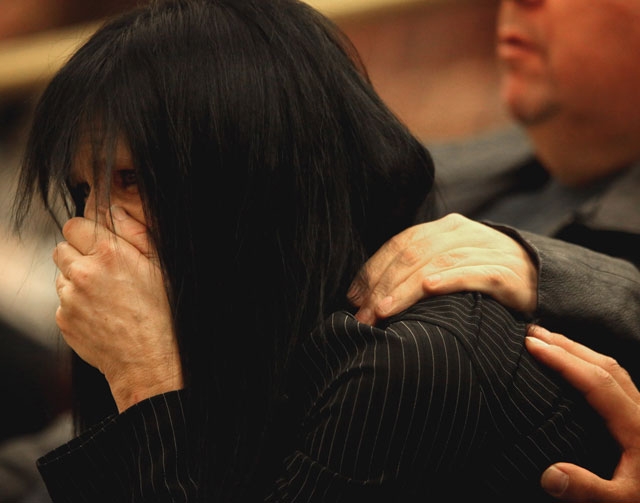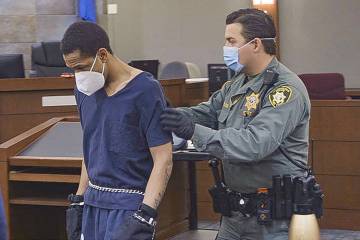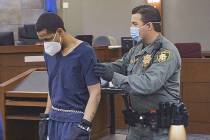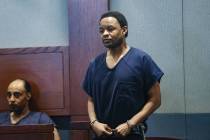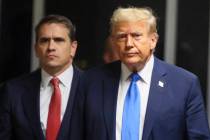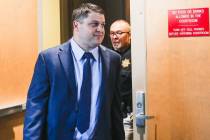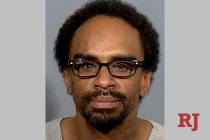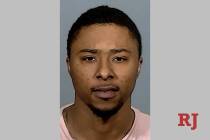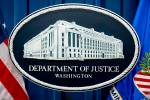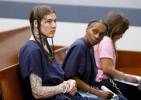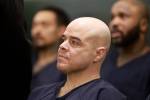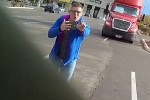First fact-finding hearing addresses miscommunication among officers
As Sgt. Michael Hnatuick devised his plan to use a beanbag shotgun and pepper spray to force a barricaded man from his car, one officer came forward with a concern.
Officer Shane Witham told Hnatuick the plan should move forward only if every officer at the scene — more than a dozen, each carrying handguns, shotguns or rifles — was aware of the plan and knew exactly when the shotgun would be fired to break a window of the white Cadillac pinned between two patrol cars for more than 20 minutes.
Witham was concerned a startled officer in the darkened apartment complex would believe someone in the car was shooting at police and return fire.
Hnatuick agreed.
“Wouldn’t want that to happen?” Assistant District Attorney Christopher Lalli asked during a hearing Thursday, more than a year after police killed Stanley Gibson.
“No,” lead Detective Clifford Mogg testified.
Except it did.
Gibson’s death helped prompt a federal investigation of the Metropolitan Police Department and sweeping changes in the department’s use-of-force policies. In a rare move, the district attorney’s office presented the case to a Clark County grand jury, which in December declined to indict anyone in connection with the death.
fact-finding review
Everything that could go wrong did go wrong for Gibson in the hours before he was shot by police the morning of Dec. 12, 2011, according to testimony at Clark County’s first fact-finding review of a fatal police shooting.
Gibson, 43, a Gulf War veteran, was shot and killed when officer Jesus Arevalo fired seven shots from his AR-15 rifle into the unarmed man’s car during a standoff that began with a mistaken report of an attempted burglary at the Alondra apartments at 2451 N. Rainbow Blvd., near Smoke Ranch Road.
And there were plenty of chances before the shooting where Gibson, who had mental health problems and had been hallucinating in the days before, could have been helped, testimony revealed.
Thursday’s review, an informal fact-finding that replaces the oft-criticized Clark County coroner’s inquest, touched on all of those issues. The new process does not have a jury, will not have testimony from citizens or the involved officers and is not legally binding. Instead of a courtroom, the hearing was held in the Clark County Commission chambers.
Only two witnesses were called Thursday: Mogg, who gave a detailed report on the findings of his investigation during four hours of questions by prosecutor Lalli and ombudsman Tony Sgro, and Michael Barnbeck, director of the radio systems bureau.
Most of the questions focused on communication problems just before Gibson was killed.
Mogg said Hnatuick’s initial plan called for officers to approach Gibson’s car from the left rear, where Gibson could not see them . At the time, it was not known whether Gibson had a weapon.
Officer Malik Grego-Smith was to shoot out the Cadillac’s rear window with a beanbag shotgun, and Hnatuick was to blast pepper spray into the car.
Arevalo was to provide cover with his AR-15 on the left side of Gibson’s car, and officer John Tromboni would cover the approaching officers with a standard 12-gauge shotgun.
But before the plan was implemented, Lt. David Dockendorf arrived on scene, took control of the operation and pulled the officers back, Mogg said.
Arevalo, assuming the plan had been called off, asked to provide cover on the right side of the command post, separated from his supervisors by a concrete trash bin enclosure. Hnatuick said yes.
A short time later, Gibson, who had been lying down in his car, sat up and began revving the engine and spinning the wheels. Gibson had done this several times, but Dockendorf hadn’t been there to see it, Mogg said.
Dockendorf reacted by grabbing Grego-Smith’s shoulder and yelling into his radio, “All right, units, we’re moving in. Shoot.”
Mogg said Dockendorf meant only that Grego-Smith was to shoot the bean-bag gun, but his command was broadcast to all because his microphone was still open. Many officers told detectives their radios were not working properly and they never heard Dockendorf’s order. Arevalo would not say what he heard, Mogg said.
But a split-second after Grego-Smith shot out the Cadillac’s rear passenger window, Arevalo fired his rifle, hitting Gibson four times.
SUPERVISOR WAS ‘HASTY’
Even if Arevalo didn’t hear Dockendorf’s order, no supervisor told him the plan was back on, Mogg said. And Dockendorf had substantially changed Hnatuick’s plan by approaching from a different angle and shooting the rear passenger-side window instead of the rear window.
“Do you believe he (Dockendorf) acted in a hasty manner in grabbing officer Grego-Smith and moving in?” Lalli asked Mogg.
“Yes,” the detective said.
Mogg said Arevalo would have been unable to see Grego-Smith shoot the window because of the concrete enclosure between him and the command center.
Dockendorf later told Mogg he was surprised at the outcome.
“Quite frankly, I was shocked that somebody had fired,” Dockendorf told detectives in a recording played at Thursday’s review.
The department’s use of force review board has yet to examine the incident. The department has not announced whether any officers have been disciplined for their actions.
In addition to new details of the shooting, more information was learned about Gibson’s contact with police in the 48 hours before his death.
On Dec. 10, two days before the shooting, three officers responded to 911 calls from Gibson’s apartment.
Gibson, who had been off his anxiety medication, tried to punch an officer. He was booked on a charge of resisting arrest, with the caveat he receive a full psychological evaluation at the Las Vegas Detention Center.
But Gibson spent less than 10 minutes with a nurse and only nine hours in jail before being released on his own recognizance because the jail was full.
Gibson then went to the Golden Nugget, where he scooped $100 in chips from a blackjack table and asked to be dealt cards. He was kicked out of the casino and cited for petty theft by the Nevada Gaming Control Board.
The following day he was again detained by police and sent for a 72-hour mental evaluation at Mountain View Hospital after he was found running in and out of traffic. The hospital released Gibson early, without treating him. Early the following morning, he was dead.
Rudy Gibson said he was glad to have a timeline of his brother’s last hours but would have preferred a coroner’s inquest. Gibson said he wanted a chance to look Arevalo in the face and hear the story in the officer’s own words.
“Oh well,” Gibson said after the hearing. “We have some answers, but a lot more questions.”
Metropolitan Police Department officials did not comment on the hearing or the fact-finding process.
Contact reporter Mike Blasky at mblasky@reviewjournal.com or 702-383-0283.
Deadly Force: When Las Vegas Police Shoot, and Kill
Las Vegas Review-Journal investigative series



